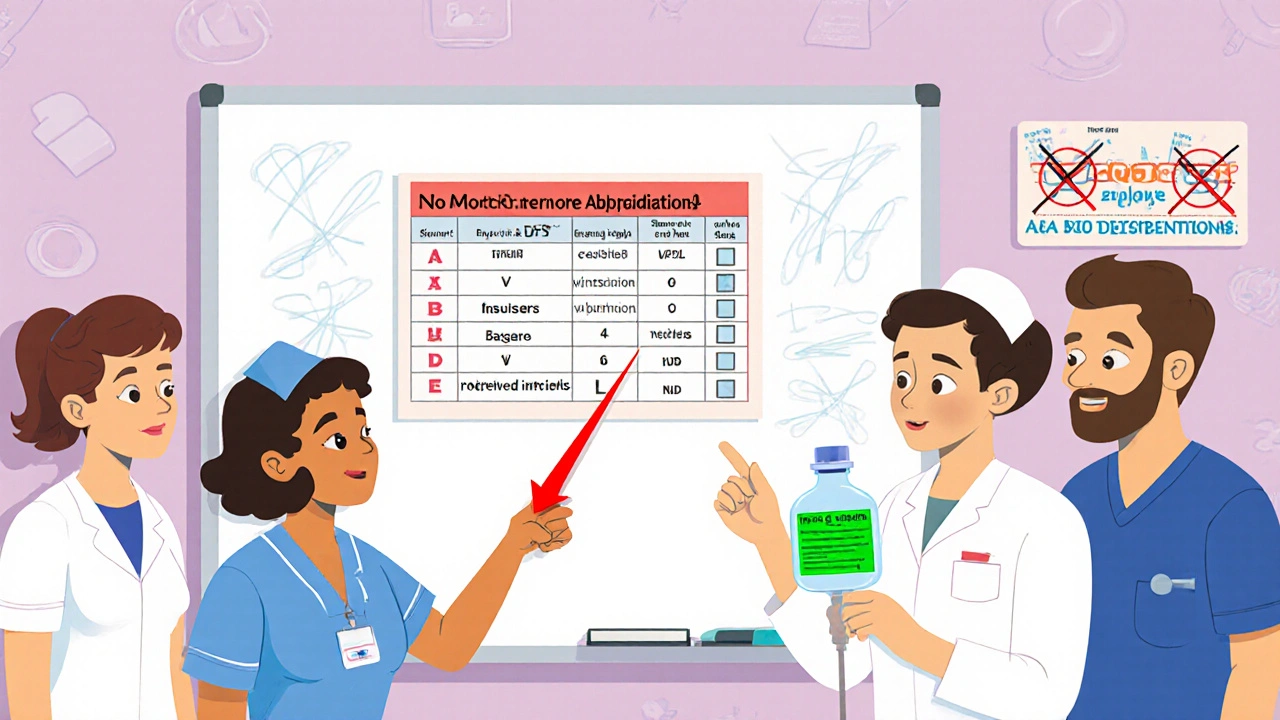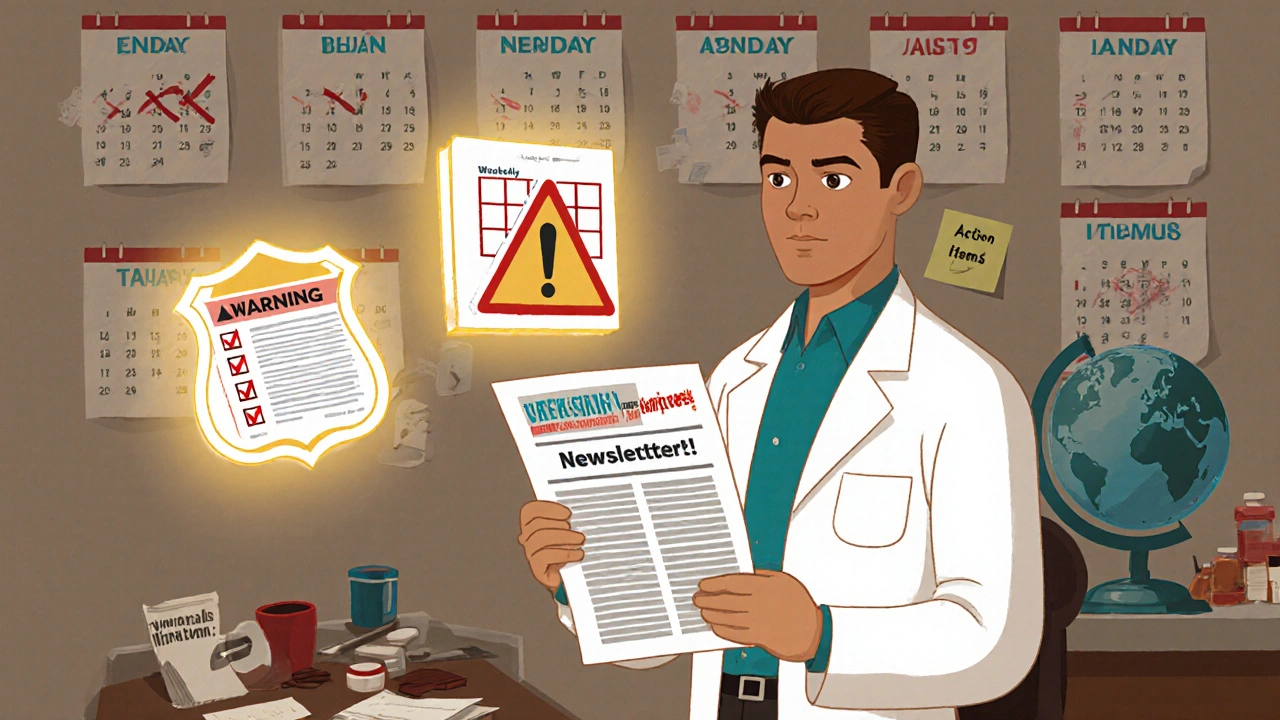When a new drug warning pops up, it’s not just news-it’s a potential lifesaver. Every year, preventable medication errors cause tens of thousands of deaths worldwide. The good news? You don’t have to wait for a tragedy to happen before acting. Professional societies and regulatory bodies publish detailed, evidence-based safety updates that can help you catch errors before they reach patients. But with so many sources, where do you even start?
Know Where the Updates Come From
You can’t follow what you don’t know exists. The most trusted medication safety updates come from organizations that track real-world errors, not just theoretical risks. The ISMP (Institute for Safe Medication Practices), now part of ECRI, is the gold standard. They collect over 2,800 medication error reports annually from hospitals and pharmacies. Their weekly Medication Safety Alert! newsletter doesn’t just report problems-it tells you exactly how to fix them.
The FDA (Food and Drug Administration) issues official drug safety communications when a medication shows serious new risks. In 2023 alone, they released 47 alerts-everything from liver damage linked to a common antibiotic to dangerous interactions with over-the-counter painkillers. These aren’t suggestions. They’re legal notices.
Specialty societies like AORN (Association of periOperative Registered Nurses) and ASHP (American Society of Health-System Pharmacists) focus on specific settings. AORN’s 2023 update on medication safety in surgery added new rules for labeling IV bags in operating rooms. ASHP gives you ready-to-use checklists for verifying high-risk drugs like insulin and heparin.
And globally, the WHO (World Health Organization) runs the Medication Without Harm initiative. While their guidance is broad, it’s the only source that connects your local practice to international standards-critical if you work in a hospital that treats international patients or uses medications imported from abroad.
Set Up Your Alert System
Reading every update isn’t realistic. You need a system that filters noise and delivers only what matters. Start with these three subscriptions:
- ISMP Medication Safety Alert! - Weekly emails. Costs $299/year for individuals. Worth every penny if you handle prescriptions, dispense meds, or manage drug inventory.
- FDA Drug Safety Communications - Free email alerts. Sign up directly on the FDA website. These are mandatory reading for anyone prescribing or dispensing medications.
- ASHP Medication Safety Resource Center - Free basic access includes core guidelines. Pay $99/year for downloadable tools and CE credits.
Don’t forget specialty sources. If you work in labor and delivery, subscribe to ACOG (American College of Obstetricians and Gynecologists) alerts on high-risk drugs like oxytocin. If you’re in surgery, AORN’s updates are non-negotiable.
Most platforms work on mobile. Set up push notifications for ISMP and FDA alerts. That way, if a new warning drops on a Friday afternoon, you’ll know before Monday morning.
Don’t Rely on Just One Source
Here’s the hard truth: if you only follow one source, you’re missing critical risks. Dr. Michael Cohen, former president of ISMP, says it plainly: “Relying on a single source for medication safety updates is as dangerous as using a single verification step in medication administration.”
Why? Because each source has blind spots.
- ISMP catches errors early-often before the FDA even knows about them. But they don’t cover regulatory changes like new black box warnings.
- FDA alerts are authoritative, but they come after harm has occurred. The average delay between a drug causing injury and the FDA warning? 47 days.
- ASHP gives you practical tools, but their updates are biennial. That means if a new risk emerges in June, you won’t get the fix until next year unless you check their free updates in between.
- WHO sets global standards, but their guidance is too general for daily use in a U.S. hospital.
Use them together. If ISMP flags a medication labeling issue, cross-check with the FDA to see if a warning is coming. If ASHP releases a new checklist, compare it to AORN’s surgical guidelines. The overlap is where the real safety lies.

Make It Part of Your Routine
Knowledge is useless if it sits in your inbox. You need to turn alerts into action.
Here’s how a busy pharmacy team in a 150-bed hospital does it:
- Each Monday, the lead pharmacist spends 20 minutes reviewing the past week’s ISMP and FDA alerts.
- They highlight any changes that affect their top 10 most-used medications.
- They share a one-page summary with the nursing and medical staff during morning huddles.
- They update their internal drug protocol sheet within 48 hours.
That’s it. No grand training sessions. No new software. Just a consistent, small habit.
AORN recommends tying updates to staff competency reviews. If their new guideline on IV bag labeling came out in October 2023, they trained every nurse during their Q1 2024 skills check. Result? A 63% drop in labeling errors in their ORs.
Even if you’re solo-like a community pharmacist or a primary care provider-do this: keep a printed copy of ISMP’s List of Error-Prone Abbreviations on your desk. Update it every January. It’s a simple step, but it stops mistakes before they start.
Watch Out for the Pitfalls
Not all updates are created equal. Some are overwhelming. Others are outdated. Here’s what to avoid:
- Information overload - ISMP sends 52 alerts a year. That’s one a week. If you’re trying to read every word, you’ll burn out. Focus on the “Action Items” section at the bottom of each alert. That’s where the change is.
- Outdated guidelines - Some hospitals still use 2021 versions of ASHP’s best practices. Check the publication date. If it’s older than two years, it’s likely obsolete. ISMP and AORN update biennially. FDA updates are real-time.
- Ignoring local context - A WHO guideline might say “use barcode scanning,” but if your hospital doesn’t have scanners, that advice won’t help. Adapt. Use checklists instead. Use color-coded labels. Find a workaround that fits your setting.
- Trusting commercial platforms - There are 17 paid safety platforms on the market. Most are marketing tools. Stick to the non-profit societies. They’re funded by grants and memberships, not sales. Their goal is safety, not profit.

What’s Changing in 2025
The landscape is evolving fast. In March 2024, ISMP released new best practices for AI-assisted prescribing and compounding pharmacy safety-two areas that didn’t exist five years ago. AORN is moving from biennial updates to quarterly micro-updates, meaning you’ll get changes faster. The FDA and ISMP are now piloting a system that pushes real-time alerts directly into EHR systems like Epic and Cerner.
By late 2025, the International Coalition of Medication Safety Organizations (ICMSO) will roll out a unified taxonomy for safety alerts. That means all sources-FDA, ISMP, WHO-will use the same language to describe risks. No more confusion between “contraindicated,” “caution,” and “avoid.”
These changes make it easier to stay current. But they also make it more urgent. If you’re not adapting now, you’ll fall behind.
Start Today
You don’t need a big budget or a team of pharmacists to get started. Here’s your 5-minute action plan:
- Go to the ISMP website and sign up for the free weekly digest (yes, even the free version has critical alerts).
- Go to the FDA Drug Safety page and click “Subscribe to Email Alerts.”
- Bookmark the ASHP Medication Safety Resource Center and check it once a month.
- Ask your supervisor: “Are we using the latest ISMP Targeted Best Practices?” If not, request it.
- Print and post ISMP’s List of Error-Prone Abbreviations in your workspace.
Medication safety isn’t about memorizing every drug interaction. It’s about building habits that catch mistakes before they happen. The tools are out there. The data is clear. The only thing missing is your next step.
How often do professional societies update medication safety guidelines?
Most major societies update biennially-ISMP and ASHP release new best practices every two years. But ISMP’s Medication Safety Alert! newsletter comes out weekly, and the FDA issues drug safety communications as new risks emerge, sometimes multiple times a week. AORN is moving to quarterly micro-updates starting in 2024, so updates are becoming more frequent across the board.
Are these safety updates free?
Some are, some aren’t. The FDA’s alerts are completely free. ISMP offers a free weekly digest, but their full subscription (Medication Safety Alert! with deeper analysis) costs $299/year. ASHP gives free access to basic guidelines, but premium tools and CE credits require a $99 annual fee. WHO materials are free. Most specialty societies like AORN and ACOG offer free summaries to the public, but full access requires membership.
What’s the difference between FDA alerts and ISMP alerts?
FDA alerts are regulatory-they come after a drug has caused harm and are legally required. ISMP alerts are proactive-they’re based on thousands of real error reports from frontline staff, often before the FDA even knows about the issue. ISMP tells you how to fix the problem. The FDA tells you the problem exists.
Do I need to be a member of these societies to get updates?
No. You don’t need to join ISMP, ASHP, or AORN to get their core safety alerts. The FDA and WHO updates are public. ISMP’s weekly newsletter is free to subscribe to. You only need membership if you want advanced tools, continuing education credits, or full access to their implementation guides.
How can I tell if a safety update is trustworthy?
Look for the source. Trust updates from non-profit, evidence-based organizations like ISMP, FDA, WHO, ASHP, and AORN. Avoid alerts from pharmaceutical companies, commercial safety platforms, or websites that sell supplements. Check if the update references real data, includes implementation steps, and is dated. If it’s vague, emotional, or lacks citations, it’s not reliable.
What should I do if my hospital doesn’t use these updates?
Start small. Print out one ISMP alert that’s relevant to your role-like the one on dangerous abbreviations-and share it with your team. Show how it prevented an error in another unit. Use data: “This alert helped reduce errors by 40% in a similar hospital.” You don’t need permission to do the right thing. Just start with one action, and others will follow.


Jeremy Samuel
November 19, 2025 AT 09:16Dana Oralkhan
November 20, 2025 AT 03:33And yes, it’s $299, but if one error gets prevented, you’ve already paid for it.
Ron and Gill Day
November 22, 2025 AT 00:39Alyssa Torres
November 23, 2025 AT 21:24It’s not about money. It’s about not killing people because you didn’t want to pay for a $2.50/week alert. I’m not being dramatic. I’m being real.
Summer Joy
November 24, 2025 AT 18:07Destiny Annamaria
November 25, 2025 AT 14:56Aruna Urban Planner
November 26, 2025 AT 09:41Nicole Ziegler
November 26, 2025 AT 19:06Bharat Alasandi
November 27, 2025 AT 17:38Kristi Bennardo
November 28, 2025 AT 03:12Johannah Lavin
November 29, 2025 AT 00:46And if you’re worried about tone, try reading the 300+ error reports they publish. Those aren’t marketing. Those are real stories of people almost dying because someone used ‘U’ for units. That’s not drama. That’s data.
Shiv Karan Singh
November 29, 2025 AT 11:55Fix staffing. Fix pay. Fix the EHRs. Then the alerts will matter.